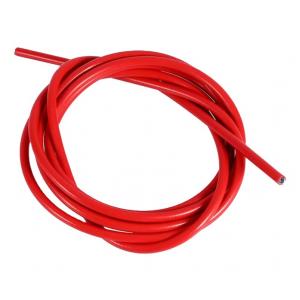
Add to Cart
Premium Bike Brake Cable , Professional Bicycle Brake Line For Mountain And Road With End End And Ferrule 6"
A bike brake cable is an essential component of a bicycle's braking system. It is responsible for transmitting the force from the brake lever to the brake caliper or brake mechanism, enabling the rider to control the braking action. Here are some key points about bike brake cables:
1. Construction: Bike brake cables are typically made of thin, high-tensile steel wires twisted together to form a cable. These wires are then coated with a layer of corrosion-resistant material, such as zinc or stainless steel, to enhance durability and longevity.
2. Diameter: The diameter of a bike brake cable can vary depending on the specific type of brake system and the manufacturer's specifications. Common diameters for brake cables are 1.5mm or 1.6mm.
3. Inner Cable: The inner cable is the core part of the brake cable and is responsible for transmitting the force from the brake lever to the brake caliper or mechanism. It consists of multiple steel wires twisted together to form a strong and flexible cable.
4. Outer Casing: The brake cable is housed within an outer casing, also known as cable housing or sheath. The outer casing protects the inner cable from dirt, moisture, and friction, ensuring smooth cable movement and reliable braking performance. It is typically made of reinforced plastic or polymer materials.
5. End Fittings: Brake cables are equipped with end fittings on both ends. One end is attached to the brake lever, while the other end connects to the brake caliper or mechanism. The end fittings provide secure connections and allow for easy installation and adjustment.
6. Compressionless Design: Brake cables often use compressionless outer casings to ensure precise and immediate braking response. Compressionless housing maintains its shape when compressed, minimizing cable flex and delivering direct force from the brake lever to the brake caliper.
7. Lubrication: Regular lubrication of the brake cable is important to minimize friction and ensure smooth cable movement. Applying a specialized cable lubricant or a light oil to the inner cable helps reduce friction and prolongs the cable's lifespan.
Proper installation, adjustment, and maintenance of bike brake cables are crucial for safe and effective braking performance. It's important to follow the manufacturer's guidelines and consult a professional if you're unsure about any aspect of brake cable installation or maintenance.





| Size(mm) | Material of inner hose | Size of steel wire(mm) | Flattening thickness of steel wire | Material of coating | Tolerance of OD | ID of inner hose(mm) |
| ∮4 | PE/POM/PTFE | 1 | 0.48/0.55 | PVC/PP/PA6 | ±0.05 | 1.5/1.4 |
| ∮5 | PE/POM/PTFE | 1.1/1.2/1.3 | 0.48/0.55/0.6/0.7 | PVC/PP/PA6 | ±0.05 | 2.2/2.0/1.9 |
| ∮6 | PE/POM/PTFE | 1.4 | 0.7 | PVC/PP/PA6 | ±0.05 | 2.4/2.6 |
| ∮7 | PE/POM/PTFE | 1.6/1.8 | 0.85/1.0 | PVC/PP/PA6 | ±0.05 | 3 |
| ∮8 | PE/POM/PTFE | 1.8/2.0 | 1.0/1.25 | PVC/PP/PA6 | ±0.05 | 3.3/3.6 |
| ∮9 | PE/POM/PTFE | 2 | 1.1 | PVC/PP/PA6 | ±0.05 | 4.1 |
| ∮10 | PE/POM/PTFE | 2.2 | 1.25 | PVC/PP/PA6 | ±0.05 | 4.6 |




